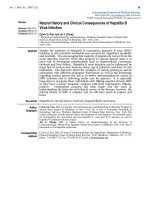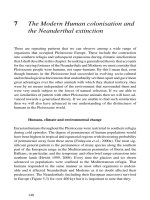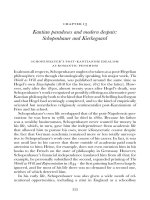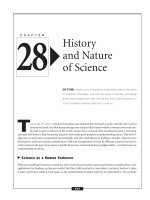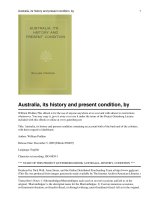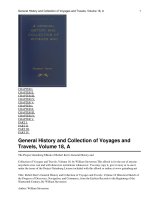modern chinese history and sociolinguistics
Bạn đang xem bản rút gọn của tài liệu. Xem và tải ngay bản đầy đủ của tài liệu tại đây (9.27 MB, 245 trang )
This page intentionally left blank
Modern Chinese
The Chinese language, spoken by over one billion people, has undergone
drastic changes over the past century in a way unparalleled at any time
previously. This book presents a comprehensive and up-to-date account of the
development of Modern Chinese from the late nineteenth century up to the
1990s, concentrating on three major aspects: Modern Spoken Chinese, Modern
Written Chinese, and the Modern Chinese writing system. It describes and
analyses in detail, from historical and sociolinguistic perspectives, the
establishment and promotion of Modern Spoken Chinese and Modern Written
Chinese and the reform of the Chinese script. Through an integrated discussion
of these three areas of the language it highlights the close interrelationships
between them and reveals the interaction of linguistic, historical, and social
factors in the development of Modern Chinese.
PING CHEN is Senior Lecturer in Chinese Language and Linguistics in the
Department of Asian Languages and Studies at the University of Queensland.
He has previously taught at UCLA, the University of Oregon, the Chinese
Academy of Social Sciences, Beijing, and the City University of Hong Kong.
He has published widely in the area of Chinese linguistics.
Modern Chinese
History and Sociolinguistics
The Pitt Building, Trumpington Street, Cambridge, United Kingdom
The Edinburgh Building, Cambridge CB2 2RU, UK
40 West 20th Street, New York, NY 10011-4211, USA
477 Williamstown Road, Port Melbourne, VIC 3207, Australia
Ruiz de Alarcón 13, 28014 Madrid, Spain
Dock House, The Waterfront, Cape Town 8001, South Africa
First published in printed format
ISBN 0-521-64197-7 hardback
ISBN 0-521-64572-7
p
a
p
erback
ISBN 0-511-04033-4 eBook
Pin
g
Chen 2004
1999
(netLibrary)
©
This book is dedicated to the memory of my father,Chen Yujia.
Contents
List of tables
ix
Prefacexi
Acknowledgementsxiii
List of abbreviationsxiv
1Introduction1
Part IModern Spoken Chinese5
2Establishment and promotion of Modern Spoken Chinese7
2.1 Development of Standard Spoken Chinese before the
late nineteenth century7
2.2 Establishment and promotion of Modern Standard Chinese from the
late nineteenth century until 194913
2.3Promotion of pKtDnghuàafter 194923
2.4 Promotion of Modern Standard Chinese in Taiwan, Hong Kong, and
Singapore30
3Norms and variations of Modern Standard Chinese34
3.1Phonology of Modern Standard Chinese34
3.2Difference between Modern Standard Chinese and the Beijing dialect37
3.3Adulterated pKtDnghuà41
3.4Norms of Modern Standard Chinese outside mainland China46
4The standard and dialects50
4.1Dialects in contact50
4.2 Socio-functional differentiation of Modern Standard Chinese and
dialects53
4.3Language policy towards dialects57
4.4Taiwan, Hong Kong, and Singapore60
Part IIModern Written Chinese65
5 Development and promotion of Modern Written Chinese67
5.1Old Written Chinese67
5.2Emergence of early Modern Written Chinese68
5.3Replacement of wényánby báihuàas Standard Written Chinese70
5.4Sources of and avenues of influence upon Modern Written Chinese82
5.5Uses of wényánand báihuàsince the 1940s87
5.6Establishment of Modern Written Chinese and status planning88
6Norms and variations of Modern Written Chinese91
6.1Newly developed grammatical norms in Modern Written Chinese91
6.2 Regional variations in the grammatical norms of Modern Written
Chinese97
6.3Newly developed lexical norms in Modern Written Chinese99
vii
6.4Regional variations in the lexical norms of Modern Written Chinese106
6.5 Efforts of corpus planning in the development of Modern Written
Chinese109
7Dialect writing114
7.1Single standard written language for dialects114
7.2Causes of the under-development of dialect writing115
7.3Current endeavours in Taiwan toward dialect writing121
7.4Implications of standardization of dialect writing126
Part IIIThe modern Chinese writing system129
8Basic features of the Chinese writing system131
8.1Typological characterization131
8.2Brief history of the Chinese script132
8.3Correlation between script and language136
8.4Merits of the Chinese script139
8.5 Motivation for reform141
8.6 Approaches to script reform146
9Simplification of the traditional writing system148
9.1Approaches to simplification148
9.2Simplification before the twentieth century148
9.3Simplification in the twentieth century150
9.4Gains and problems157
9.5Objections to the Second Scheme159
9.6Simplification of script outside mainland China162
10Phonetization of Chinese164
10.1Efforts by Western missionaries164
10.2Schemes proposed by native Chinese165
10.3Groupings of schemes167
10.4Five representative schemes178
10.5Phonetization in Taiwan and elsewhere189
11Use and reform of the Chinese writing system:present and future191
11.1Recent developments191
11.2Change in policy on script reform196
11.3Prospects of script reform197
12Conclusion202
Notes204
References210
Index222
viii
Tables
Table 1.1 Periodization of Chinese 1
Table 2.1 Percentage of population with comprehension and speaking proficiency in
pKtDnghuà 28
Table 3.1 Initials of Modern Standard Chinese 35
Table 3.2 Finals of Modern Standard Chinese 35
Table 3.3 Tones of Modern Standard Chinese 36
Table 3.4 Rhotacized finals of Modern Standard Chinese 36
Table 3.5 Five proficiency levels of pKtDnghuà in Shaoxing 44
Table 4.1 Patterns of uses of local dialect and pKtDnghuà in Shaoxing 54
Table 4.2 Patterns of uses of Min and pKtDnghuà in three Min dialect cities 54
Table 4.3 Patterns of uses of Cantonese and pKtDnghuà in major Cantonese areas 55
Table 4.4 Patterns of uses of Southern Min and guóyK in home and work-place in
Taiwan 61
Table 4.5 Patterns of uses of Southern Min and guóyK in market places in Taiwan 61
Table 4.6 Most common languages used by parents of Year 1 Chinese students in
Singapore 63
Table 6.1 Lexical variations among mainland China, Taiwan, Hong Kong, and
Singapore 106
Table 8.1 Number of characters in Chinese history 135
Table 8.2 Coverage rate of characters in publications in Modern Chinese 137
Table 8.3 Number of characters pronounced as ji 137
Table 8.4 Correspondence between characters and morphemes 138
Table 8.5 Percentage of monosyllabic words in Chinese history 139
Table 9.1 Correlation between incidence and average number of strokes of characters
used in Analects 161
Table 10.1 Scheme of guAnhuà zìmK 179
Table 10.2 Scheme of zhùyCn zìmK 181
Table 10.3 Scheme of guóyK luómFzì 183
Table 10.4 Scheme of latinxua sin wenz 185
Table 10.5 Scheme of guóyK zhùyCn fúhào dì èr shì 190
ix
Preface
The Chinese language has undergone drastic changes over the past 150
years in a way that is unparalleled in Chinese history. In writing this book,
I have hoped to present a comprehensive account of the development of
Modern Chinese mainly from the late nineteenth century up to the 1990s,
concentrating on three major aspects, namely Modern Spoken Chinese,
Modern Written Chinese, and the Modern Chinese writing system. I have
attempted to describe and analyse the establishment and promotion of
Modern Chinese in its spoken and written forms, and the reform of
Chinese script in a historical and social context. Treating the topics in
question in an integrated way, I hope I have been in a position to reveal
the close interrelationships between spoken Chinese, written Chinese,
and the Chinese writing system, and to highlight the interaction of lin-
guistic, and historical, social factors at work in the process. In this book,
which has incorporated my own research results over the years and the
gains of the latest research reported in the literature in Chinese and
Western languages, I have aimed to provide readers with up-to-date
findings in the field.
The book was written primarily for students and teachers of Chinese
language and Chinese linguistics. It may be used for the relevant subjects
at the upper undergraduate and postgraduate level at university, or read
by those who have studied Chinese for some years. I will be very pleased if
my fellow researchers in Chinese linguistics also find something useful
in it. Since the linguistic phenomena are discussed in close connection
with the historical and social context, and with frequent reference to
similar phenomena in other languages, it will also appeal to specialists
in other fields of Chinese studies, specialists in historical linguistics and
sociolinguistics, and to anyone who takes an interest in Chinese language,
Chinese literature, Chinese culture, and Modern China.
I am grateful to many people for making the completion of the work
possible. First of all, I must acknowledge a special debt of gratitude to Lü
Shuxiang, who initiated me in the study of Chinese language both in the
traditional philological approach and from the perspective of modern
linguistics, and was the first to arouse my interest in many of the issues
under discussion in this book when I was an MA student under his super-
vision in the Institute of Linguistics of the Chinese Academy of Social
Sciences. He has been a shining example for me to emulate in scholarly
research. I am greatly indebted to Sandra A. Thompson for her interest in
xi
this book and for her advice and encouragement from the beginning of
the work. She has always been a highly valued source of inspiration and
support to me in this work, as well as in many of my other research pro-
jects since my years at UCLA.
I wish to acknowledge my indebtedness to One-soon Her, Thomas
H. T. Lee, Perry Link, Jerry Norman, and an anonymous reviewer for the
Cambridge University Press, who read draft versions of the book, and
provided valuable comments, criticisms, and suggestions. At various
stages of research for this book, I benefited from advice and assistance
from William Bright, Hilary Chappell, Robert L. Cheng, South Coblin,
Florian Coulmas, Feng Zheng, Nanette Gottlieb, Jiang Lansheng, Liu Jian,
Kam Louie, Victor H. Mair, Tsu-Lin Mei, Alain Peyraube, Alan Rix,
Malcolm Skewis, Chaofen Sun, Roland Sussex, R. McMillan Thompson,
Benjamin K. Y. T’sou, William S. Y. Wang, Xu Liejiong, Eric Zee, Zhong
Zhemin, and Zhou Youguang. To all of them I am deeply grateful. This
project was in part supported by two grants from the Australian Research
Council, and by the University of Queensland through its University
Research Grant and Special Studies Program. I alone am responsible for
all the viewpoints expressed in the book.
Finally, I wish to record my gratitude to my wife, Jean, and to our chil-
dren Fay and Laura, for their unfailing love and support.
xii
Acknowledgements
Other versions of parts of the work have appeared elsewhere:
Chapters 5–6
Chen, Ping 1993. Modern Written Chinese in development, Language in Society
22(4), 505–37. Reprinted with the permission of Cambridge University Press.
Chapter 7
Chen, Ping 1996. Modern Written Chinese, dialects, and regional identity,
Language Problems & Language Planning 20(3), 223–43. Reprinted with the
permission of John Benjamins Publishing Company.
Chapter 10
Chen, Ping 1996. Toward a phonological writing system of Chinese: a case study
in writing reform, International Journal of the Society of Language 122, 1–46.
Reprinted with the permission of Mouton de Gruyter. A Division of Walter de
Gruyter & Co.
We gratefully acknowledge permission by the publishers to use the
copyright materials.
xiii
Abbreviations
CL classifier
DUR durative aspect
PFV perfective aspect
Q question
xiv
1 Introduction
Chinese is the native language of approximately a billion people distrib-
uted over vast geographical areas of the world. It is the official language of
mainland China and Taiwan. It is one of the two official languages in
Hong Kong, where ethnic Chinese constitute more than 95 per cent of the
local population. It is one of the four official languages of Singapore,
where about 75 per cent of population are ethnic Chinese. It is also rea-
sonably maintained by about 30 million Chinese scattered in other parts
of the world.
Genealogically, Chinese belongs to the family of Sino-Tibetan. The
earliest reliable records of Chinese in the form of jiFgKwén ‘oracle bone
script’ date back more than 3,000 years. Much controversy surrounds the
periodization of the language since then, partly due to lack of sufficient
documentary evidence on the chronological changes in the language,
particularly in the pre-modern periods of its evolution, and partly due to
the fact that periodization based on each of the three main components
of the language, namely, phonology, grammar, and lexicon may not
always be co-extensive (Peyraube 1988, 1996; S. Jiang 1994; Chan and Tai
1995). The periodization adopted in this book is first and foremost based
upon changes in grammar, which may sometimes be co-extensive with
phonological, and to a lesser extent, lexical development of the language.
As elaborated in Lü (1985a, 1985b), Norman (1988), Peyraube (1988,
1996), Ohta (1991), Mei (1994), inter alia, each period is marked by some
conspicuous innovations in syntax and morphology, the details of which
need not concern us here. A sketch of the periodization is presented in
Table 1.1.
Archaic Chinese (ShànggK HànyK) is represented by the language used
in classic works of the pre-Qin period and the Western Han dynasty.
Writings from the Eastern Han onward, while basically following the style
of Archaic Chinese, displayed an increasing number of innovations in
grammar and vocabulary, which are believed to be reflective of changes
in the contemporary vernacular.
1
It is referred to as Medieval Chinese
(ZhDnggK HànyK), which represents a transitional period. Archaic Chi-
nese and Medieval Chinese constitute Old Chinese (GKdài HànyK). The
appearance of substantial texts in mainly vernacular style in the late Tang
dynasty marked the beginning of Pre-Modern Chinese (Jìndài HànyK). A
growing number of emergent grammatical, lexical, and phonological fea-
tures are attested in texts of this period and thereafter, which presumably
1
reflect corresponding developments in the language shortly before and
during the period. The next ten centuries or so constituted the formative
years of Modern Chinese (Xiàndài HànyK) during which period almost all
the most important characteristic features gradually took shape. By the
early Qing dynasty, all the major changes in grammar, phonology, and
basic vocabulary that characterize Modern Chinese had been completed.
Influences from Western languages and Japanese aside, present-day Chi-
nese differs little in grammar, phonology, and basic vocabulary from the
vernacular found in Hónglóu mèng, a novel written in the mid eighteenth
century.
2
What is known as the Chinese language comprises dozens of dialects
which may be mutually unintelligible.
3
Again, opinions differ as to their
grouping. This book follows the framework in Norman (1988) and B. Xu
and Zhan (1988) in classifying all the dialects into seven major groups,
differentiated mainly on the basis of phonological features, and, to a
lesser extent, also in terms of vocabulary and grammar. The major dialect
2
Table 1.1 Periodization of Chinese
Archaic Chinese Shang dynasty (ca. 1700–1100 BC)
Western Zhou dynasty (ca. 1100–771 BC)
Spring and Autumn period (770–476 BC)
Warring States period (475–221 BC)
Qin dynasty (221–206 BC)
Western Han dynasty (206 BC – AD 25)
Medieval Chinese Eastern Han dynasty (AD 25–220)
Wei-Jin period (220–420)
Southern and Northern dynasties (420–589)
Sui dynasty (581–618)
Early and Middle Tang dynasty (618–907)
Pre-Modern Chinese Late Tang dynasty
Five dynasties period (907–60)
Northern Song dynasty (960 –1127)
Southern Song dynasty (1127–1279)
Yuan dynasty (1206 –1368)
Ming dynasty (1368–1644)
Modern Chinese Qing dynasty (1616–1911)
Twentieth century
3
groups are Beifanghua (Mandarin),
4
Wu, Yue (Cantonese), Min, Kejia
(Hakka), Xiang, and Gan, of which Mandarin is by far the largest group,
with its native speakers accounting for the majority of the Chinese popu-
lation.
5
The non-Mandarin groups are also called the Southern dialects.
Each of the major dialect groups is in turn comprised of a large number
of varieties that are related to each other in terms of a hierarchy with
three main levels, sub-dialect, vernacular, and accent. For example, fol-
lowing the traditional classification, Mandarin is composed of four
major sub-dialects, namely, Northern, Northwestern, Southwestern, and
Jiang-Huai, all of which may be further divided into different groups of
vernaculars and accents. The standard form of Modern Chinese is known
by several names. It is called pKtDnghuà ‘the common language’ in main-
land China, guóyK ‘national language’ in Taiwan, and huáyK ‘Chinese
language’ in Singapore.
This book attempts to present a historical and sociolinguistic profile of
Modern Chinese. It will focus on its development and major features of
structure and use from the late nineteenth century up to the 1990s, and in
the context of a modernizing Chinese society. The book is composed of
three parts, concentrating on the spoken form, the written form, and the
writing system respectively.
Part I
Modern Spoken Chinese

